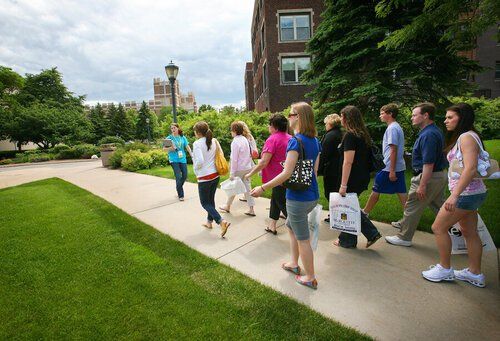This page is licensed under Creative Commons under Attribution 4.0 International. Anyone can share content from this page, with attribution and link to College MatchPoint requested.
3 Reasons You Should Do College Visits With Your Student
With spring breaks just around the corner, many families are planning their pilgrimage to potential colleges. With so much information readily available online—virtual tours, videos, and student reviews—it can be tempting to skip the campus visits altogether. But while online resources can offer helpful insights, nothing compares to stepping foot on campus. At College MatchPoint, we encourage all families to prioritize at least one college trip during the decision-making journey. These visits can bring clarity, reduce stress, and ensure your student makes an informed choice about where they will spend the next four years.

Here are three key reasons to plan college visits this spring:
1. Trying It On: Experiencing Campus Life in Person
Guidebooks, websites, and videos can only tell you so much. Walking across a campus, sitting in on a class, or eating lunch in the dining hall brings the college experience to life in a way that digital resources simply cannot. For many students, visiting a campus makes college feel real for the first time. That sense of "trying it on" helps them begin to imagine themselves living and learning there, which is critical for finding the right fit.
College is a significant commitment—four years of academics, friendships, and personal growth—and it’s difficult to get a true sense of a school without being there. A student might walk through a campus and feel an immediate connection, or they might realize something feels "off." Both are valuable insights. For example, they might love a university's facilities but feel the campus vibe isn’t right for them, or vice versa. Either way, visiting in person allows them to explore these feelings and reflect on what matters most.
Pro Tip: During the visit, encourage your student to observe how students interact with one another and ask themselves, Can I see myself here? Sitting in a dining hall or library can offer a snapshot of campus life that brochures and websites can’t replicate.
2. Too Big? Too Small? Just Right?
College size is one of the most misunderstood factors in the search process, often driven by trends or assumptions. Many students say, “I want to go to a college bigger than my high school,” particularly during the current era of large state school popularity. But these preferences can shift dramatically once students step on campus. Size is about much more than a number—visiting different types of colleges helps students truly understand what “big” or “small” feels like.
Smaller colleges, for instance, can surprise students with their vibrant, close-knit communities and access to resources that are vastly different from their high school experiences. On the other hand, visiting large campuses can help students gauge whether they’re excited by the energy or overwhelmed by the scale. Seeing both types of campuses allows students to clarify their preferences and make decisions based on their own experiences, rather than preconceived ideas.
What to Look For on a Visit: Encourage your student to pay attention to class sizes, the campus layout, and student engagement. At smaller schools, do they notice professors interacting closely with students? At larger universities, how easy is it to navigate the campus or find student support services? These observations can make the difference between a school that looks good on paper and one that feels like home.
3. Revealing Priorities: What Matters Most to Your Student?
One of the most valuable aspects of a campus visit is what it reveals about your student’s priorities. After the visit, listen closely to what they share. Are they raving about the state-of-the-art gym? Did they connect with a professor or find the dining hall food surprisingly impressive? These details may seem small, but they offer clues about what your student values most in their college experience.
For some students, their excitement might center around academics—such as a research lab, innovative program, or engaging faculty. For others, it could be the dorms, student spirit, or the feel of the surrounding community. By comparing these highlights across multiple campuses, your student will begin to develop a clearer sense of their must-haves. These insights are critical when narrowing down college options and can help you both focus on schools that meet their goals and priorities.
Pro Tip: Use a campus visit evaluation scorecard to keep track of impressions, priorities, and lingering questions. Take notes during or immediately after the visit to capture fresh observations—these details will be invaluable when making final decisions.
Making the Most of Campus Visits
Planning ahead ensures you get the most out of each college trip. Start by scheduling official campus tours and information sessions through the admissions website. Many colleges also offer opportunities to sit in on classes, meet with professors, or speak with student ambassadors—take advantage of these whenever possible. While on campus, encourage your student to lead the way and ask questions.
Here are a few areas to prioritize during visits:
- The Admissions Office: Stop by to demonstrate interest and fill out any forms to ensure your visit is tracked. Meeting your area admissions representative can also be a valuable connection.
- Key Facilities: Check out classrooms, dorms, dining halls, and recreation centers—places where your student will spend most of their time.
- The Surrounding Community: Spend some time exploring the local area to help your student imagine life outside the campus bubble.
- Current Students: If possible, strike up casual conversations with students on campus to hear about their experiences firsthand.
Remember, these visits are about your student taking the lead. As a parent, it’s important to ask thoughtful, open-ended questions and give your student space to process their impressions.
The Bottom Line: Why College Visits Matter
Campus visits play a critical role in the college search process. They help students move beyond rankings and glossy brochures to experience each college for themselves. By visiting campuses, students can refine their preferences, clarify their priorities, and ultimately find the school that feels like the best fit. For families, these visits are also an opportunity to bond, explore new places, and support your student in one of their most important life decisions.
So as you plan your spring, make time to explore campuses together. Whether it’s your student falling in love with a school you didn’t expect or discovering what truly matters to them, campus visits are full of surprises—and they’re worth every mile.


